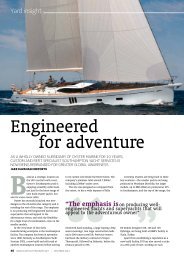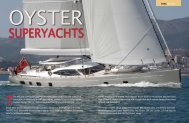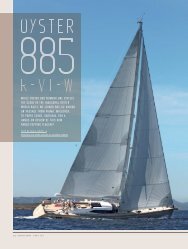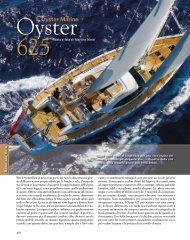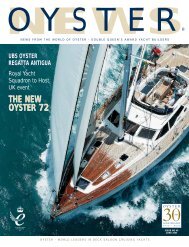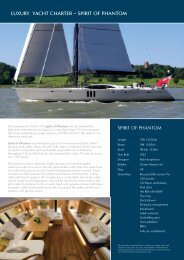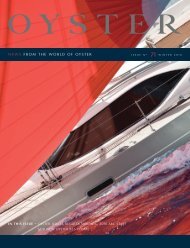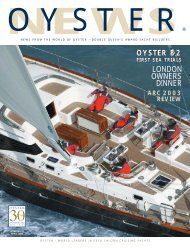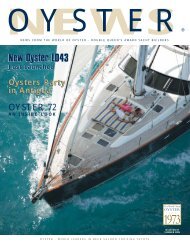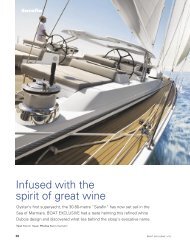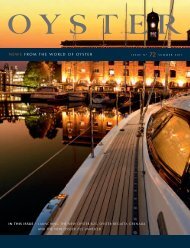Download PDF - Oyster News 66 - Oyster Yachts
Download PDF - Oyster News 66 - Oyster Yachts
Download PDF - Oyster News 66 - Oyster Yachts
You also want an ePaper? Increase the reach of your titles
YUMPU automatically turns print PDFs into web optimized ePapers that Google loves.
“As we journeyed south we<br />
encountered more and<br />
more ice with each passing<br />
day. Nights were less than<br />
peaceful and we often had<br />
to get up to move small<br />
chunks of ice clunking<br />
against Billy Budd’s hull<br />
before they could cause<br />
any harm.<br />
”<br />
40 www.oystermarine.com<br />
South, south, south... continued<br />
catch very occasional glimpses of the mountains. Their lofty peaks would suddenly appear,<br />
high and inaccessible.<br />
When we reached Vernaski, the Ukrainian Antarctic station, we had reached the southernmost point<br />
of our voyage. That evening we drank a toast in the world’s most southerly bar where Caterina, our<br />
young ski instructress, proved a major hit with the base’s scientists and staff who challenged her to<br />
a vodka drinking competition!<br />
The next morning we made our way north again, to Port Lockroy, a large bay with a museum that<br />
attracts tourist ships. We anchored in a nicely sheltered fjord, but had to move because the wind<br />
turned and ice began coming in. It even reached as far as the bay, so Clive spent a sleepless night<br />
checking that Billy Budd didn’t get surrounded and damaged by mini icebergs and growlers.<br />
The skipper of the boat Pelagic Australis, which was anchored near us, hailed us over the radio at<br />
one point when he was woken by larger chunks of ice hitting his boat. The weather was dreadful,<br />
the barometer hits its lowest point – 960 mb and there was a 60-knot wind! So we stayed aboard<br />
and only went ashore to visit the museum where we made a few purchases.<br />
The locals said that the weather had been particularly bad so far this year with very little sun, high<br />
winds and squalls. Which was a pity but it also gives us the perfect excuse to visit another time!<br />
Sadly we had to start thinking about our return journey and checked the weather bulletins.<br />
We had to get to Ushuaia by February 28 at the very latest and we couldn’t risk being slowed<br />
or stopped in our tracks by a squall in the middle of the Drake Channel. Our plan was to leave<br />
the Antarctic around February 23rd or 24th but the Gribs was forecasting 60 knot winds for the<br />
23rd – that means big seas and waves – and in the Drake Channel.<br />
So we set off from Port Lockroy at dawn on the morning of the 20th. We discovered that our radar<br />
wasn’t working so stopped off at Melchiorre Bay, where a base is located, though now closed, to try<br />
to fix it. Anchoring was tricky as the wind was high and the sea rough. Richard and Clive climbed the<br />
mast to try to find out what the problem was but there was nothing they could do. So we set off for<br />
the open sea with an 800 mile trek ahead of us, hoping that it wouldn’t be too rough.<br />
It was rough but not overly so, just enough to do the trick. Perhaps it was our emotions, the fact<br />
that we had to leave so quickly and the forecast of storms in two days, taking their toll<br />
psychologically as some of the crew fell prey to a bout of severe seasickness. It was almost a bow<br />
sea. Even though the waves weren’t too bad they really slammed the bow and with each slap the<br />
already pale faces got paler. It’s wasn’t exactly pleasant for the rest of us either as every time the<br />
bow slammed into the sea, a shudder ran through the entire boat from stem to stern, before it<br />
started all over again.




